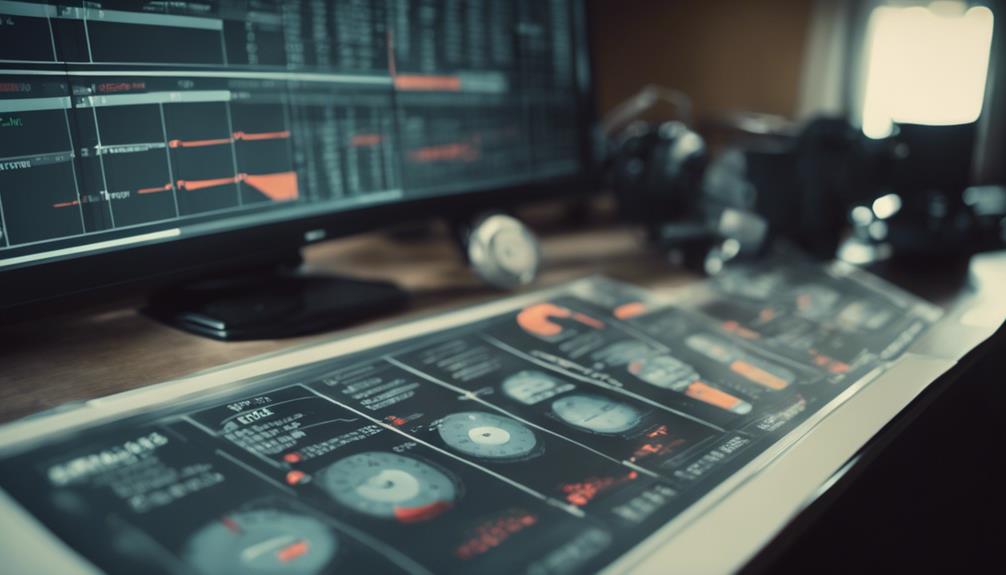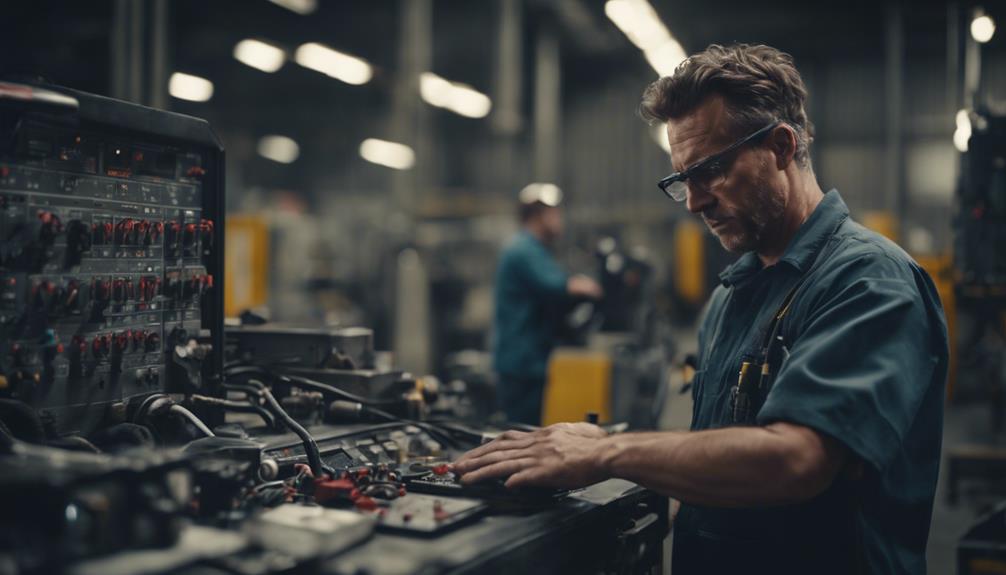Maintain equipment by establishing a schedule for routine checks and part replacements. Conduct regular inspections and use monitoring systems to track performance. Opt for proactive maintenance to prevent costly repairs and extend lifespan. Prioritize critical assets for efficient upkeep. Utilize digital tracking systems for streamlined maintenance activities. Train personnel to identify issues promptly and conduct daily equipment checks. Implement preventive maintenance strategies supported by management systems. Enhance efficiency and longevity by following routine inspection practices. Following these top professional tips can boost equipment performance and longevity, leading to fewer breakdowns and repair costs.
Key Maintenance Planning Strategies
To effectively manage the upkeep of your professional equipment, begin by establishing key maintenance planning strategies. Maintenance planning involves creating a maintenance schedule, which can reduce repair costs by up to 25%.
By implementing routine maintenance programs when acquiring new equipment, you can improve its longevity. Regular inspections, part swaps, and testing are essential components of a maintenance plan to make sure your equipment functions at its best.
Taking a proactive approach to maintenance by conducting preventative maintenance tasks can help you avoid unexpected breakdowns and costly repairs. Utilizing monitoring systems to track machine performance and indicate maintenance needs is important in staying ahead of potential issues.
Incorporating technology for tracking maintenance tasks can streamline processes and reduce errors, making it easier to keep your equipment in top condition. By following these key maintenance planning strategies, you can ensure the smooth operation and longevity of your professional equipment.
Optimal Maintenance Strategy Selection
When considering best maintenance strategies for your equipment, remember the key points:
- Regular check-ups, timely repairs, and preventive measures are essential.
- Tailoring your maintenance approach based on asset criticality and usage can help maximize performance and minimize unexpected breakdowns.
- Make sure to choose the right strategy to balance costs and equipment reliability effectively.
Regular Check-Ups
Regular check-ups play an essential role in determining the most effective maintenance strategy based on the equipment's current condition. By conducting regular check-ups, you can shift from reactive to proactive maintenance, ensuring ongoing equipment health.
These check-ups are a form of preventive maintenance, allowing you to catch potential issues early before they escalate into costly breakdowns. Scheduled check-ups not only keep your equipment running efficiently but also extend its lifespan.
Additionally, through these regular inspections, you gain valuable insights that inform maintenance scheduling and resource allocation decisions. Embrace the practice of check-ups as part of your maintenance strategy to optimize equipment performance and minimize downtime.
Timely Repairs
For ideal maintenance strategy selection, prioritize timely repairs to minimize costs and enhance equipment reliability. Timely repairs can reduce maintenance costs by up to 40% by addressing issues before they escalate, ultimately improving equipment reliability and extending its lifespan.
Opting for the right maintenance strategy not only decreases downtime by 50% but also boosts productivity. Implementing preventive maintenance further reduces emergency repair expenses by 12-18%. Additionally, selecting proactive maintenance based on asset criticality can prevent up to 75% of equipment failures.
Preventive Measures
To optimize equipment performance and minimize maintenance costs, prioritize preventive measures by selecting the most suitable maintenance strategy for your assets based on criticality analysis.
Implementing preventive maintenance can help you avoid costly downtime and unexpected equipment failures. By conducting routine maintenance tasks such as inspections, cleaning, and lubrication, you can extend the lifespan of your assets and guarantee they operate efficiently.
Additionally, leveraging predictive maintenance techniques can assist in identifying maintenance needs proactively, reducing the likelihood of corrective maintenance after equipment failures. Choose the right maintenance approach for each asset based on its criticality to streamline maintenance efforts and enhance overall equipment reliability.
- Prioritize preventive maintenance to prevent breakdowns.
- Implement routine maintenance tasks for peak performance.
- Utilize predictive maintenance to forecast maintenance needs.
- Minimize corrective maintenance post equipment failures.
- Select maintenance strategies based on criticality analysis.
Asset Criticality Assessment Techniques
When evaluating asset criticality, consider the significance of each asset for daily operations to effectively prioritize maintenance actions and resources.
Asset criticality assessment plays an important role in the maintenance plan by categorizing assets based on their importance. Highly critical assets demand immediate attention to prevent disruptions that could impact operations. By prioritizing maintenance efforts using this assessment, teams can focus on the most essential assets first, ensuring smooth operations.
Evaluating the impact of asset failure on daily operations and business outcomes is key to understanding the level of criticality. This understanding allows maintenance teams to allocate resources efficiently and address potential issues proactively. Prioritizing maintenance based on asset criticality helps prevent costly downtime and improves overall equipment reliability, ultimately leading to enhanced operational efficiency and reduced risks associated with equipment failures.
Efficient Maintenance Activity Tracking

Consider incorporating a digital maintenance tracking system to enhance efficiency in monitoring maintenance activities and optimizing workflows. By utilizing a maintenance management system, you can reduce maintenance costs considerably.
Implementing digital tracking methods can lead to a 30% reduction in emergency repair costs, while automated tracking systems enable timely maintenance interventions, reducing equipment downtime by up to 45%. Software integration can further streamline workflows and decrease maintenance costs by up to 25%.
This enhanced tracking not only improves scheduling but also increases maintenance productivity by 28%. Embracing these digital tools can revolutionize your maintenance processes and help you achieve cost savings while ensuring your equipment receives the attention it needs promptly.
Essential Maintenance Personnel Training
Enhance equipment upkeep efficiency by prioritizing essential maintenance personnel training. Training maintenance personnel is vital as it reduces machinery damage risks by improving their understanding of equipment operation.
When operators are properly trained, they can promptly identify malfunctions, leading to timely repairs and maintenance. Additionally, well-trained personnel can efficiently conduct daily equipment checks, which ultimately enhances equipment longevity and performance.
Providing in-house training for technicians and operators establishes a strong foundation for effective equipment upkeep practices. Furthermore, maintenance personnel trained to follow manufacturer guidelines can prevent warranty voiding and guarantee equipment longevity.
Importance of Maintenance Management Systems

If you want to optimize your system efficiency, implement preventive maintenance strategies, and plan maintenance based on data-driven insights, understanding the importance of Maintenance Management Systems is vital.
These systems can greatly reduce maintenance costs, increase equipment uptime, and decrease breakdowns.
System Efficiency Optimization
To maximize your system efficiency, implementing a maintenance management system is crucial. By utilizing these systems, you can extend equipment lifespan, improve reliability, and enhance resale value.
Integrating software for tracking guarantees timely inspections and servicing, ultimately boosting performance. Maintenance management systems streamline record-keeping, making it easier to track maintenance activities and equipment history efficiently.
Businesses that adopt these systems can reduce maintenance costs by up to 25% through better tracking and scheduling. Additionally, technology-driven maintenance management can lead to a significant 28% increase in overall equipment effectiveness.
Preventive Maintenance Strategies
Implementing preventive maintenance strategies is vital for ensuring the longevity and efficiency of your equipment, especially when supported by maintenance management systems. Performing preventative maintenance can reduce maintenance costs by up to 12% and downtime by 5% to 20%.
To create a maintenance schedule, keep accurate records of all maintenance activities. It's essential to keep spare parts on hand for quick replacements and repairs. Regularly cleaning equipment helps keep it in excellent condition and reduce friction, extending its lifespan.
Organizations utilizing maintenance management systems experience a 25% reduction in overall maintenance costs. By implementing these strategies, you can decrease emergency maintenance work orders by 30% and extend your equipment's lifespan by 20% to 40%.
Data-Driven Maintenance Planning
When considering the importance of Maintenance Management Systems, one can't overlook the significant impact data-driven maintenance planning has on equipment efficiency and longevity. By utilizing CMMS software, you can effectively manage maintenance costs, reduce breakdowns, and minimize emergency work, ultimately enhancing equipment efficiency.
This proactive approach helps in decreasing maintenance backlog, ensuring that issues are addressed promptly before they escalate. Implementing a Maintenance Management System not only boosts equipment lifespan but also optimizes overall equipment effectiveness.
Embrace data-driven maintenance planning to discover substantial improvements in equipment performance and reliability. Remember, a well-maintained system is a productive system.
Routine Equipment Inspection Practices

Regular equipment inspections play a crucial role in maintaining the functionality and longevity of your professional gear. By incorporating regular maintenance into your routine, you can greatly reduce costs associated with repairs and replacements. Utilizing an inspection checklist ensures that no aspect of your equipment goes unchecked, helping to identify potential issues before they escalate. Preventative maintenance through scheduled inspections not only cuts maintenance costs by 30% but also prevents unexpected downtime and delays in your operations.
Thorough inspections contribute to enhancing the overall performance of your equipment, ensuring that it operates at its peak efficiency. By adhering to a structured inspection regimen, you can prolong the lifespan of your gear and maximize its utility. Remember, detailed inspections aren't just about identifying current issues but also about proactively addressing future concerns. Make routine equipment inspections a priority to safeguard your investment and optimize your professional equipment's performance.
Conclusion
To sum up, by implementing these top professional tips for equipment upkeep, you can guarantee the longevity and efficiency of your assets.
For instance, a manufacturing company saw a significant decrease in downtime and repair costs after implementing routine equipment inspection practices and asset criticality assessment techniques.
Remember, proactive maintenance planning and efficient tracking of maintenance activities are key to maximizing the lifespan of your equipment.